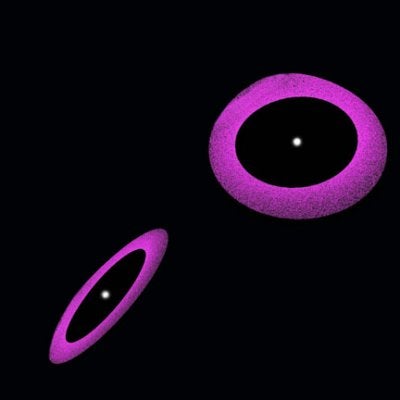Two astronomers are playing the role of stellar forensic scientists as they reconstruct an inter-stellar heist. What they found could explain the Kuiper Belt’s clean-cut outer edge and shed new light on the elliptical orbit of the recently discovered Sedna.
Scott Kenyon of the Smithsonian Astrophysical Observatory in Cambridge, Massachusetts, and Benjamin Bromley of the University of Utah in Salt Lake City created a computer simulation demonstrating the effect a star’s close flyby would have had on our solar system. The simulation shows a star passing by far enough from the Sun that it did not disrupt Neptune’s orbit; close enough that an interstellar exchange of debris took place between the star and our Sun; and late enough in the Sun’s formation that Sedna-like objects had time to form within the Kuiper Belt.
According to Kenyon and Bromley’s simulation, such an encounter took place more than 4 billion years ago — 100-200 million years after the Sun’s birth. A close and violent encounter between the Sun and a star most likely happened early in the Sun’s youth, especially if it grew up in a crowded star cluster. Had the encounter happened later than the simulation predicts, the passing star would’ve absconded with most comets residing in the nearby Oort Cloud. The abundance of comets in the Oort Cloud, though, is evidence of an early encounter between our Sun and a star.
The computer models indicate thousands, possibly millions, of alien objects were stripped from the passing star. At this point, none has yet been identified. During the simulations, the Sun captures up to one-third of the star’s objects, adding them to the Kuiper Belt.
In fact, the models provide a 10 percent chance that Sedna was captured during the flyby.
“It’s possible that some of the objects in our solar system actually formed around another star,” Kenyon says.
The Kuiper Belt spans between 35 and 100 AU from the Sun. Most Kuiper Belt objects (KBOs) move in circular orbits around the Sun. An object with an inclined orbit, therefore, stands out; Sedna’s inclined orbit leads astronomers to believe a passing star pulled it out of a more typical, circular KBO orbit.
The passing star could have pulled objects like Sedna out of their circular orbits and also spun away millions of KBOs. This would have trimmed the outer edge of the Kuiper Belt to 50 AU from the Sun while leaving some of the passing star’s own objects behind. “There may not have been an equal exchange, but there was certainly an exchange,” says Bromley.
Kenyon, Bromley, and fellow astronomers will proceed to search for objects with highly inclined orbits. Because only captured objects have orbits inclined more than 40°, detection of such objects would confirm the presence of foreign objects in our solar system. Astronomers will predict the distribution of the captured objects in our solar system with computer models and design a project to search for them using ground-based telescopes.
When the census of the comet population inside the Oort Cloud is complete, this also will help establish the accuracy of the Kenyon-Bromley models.










